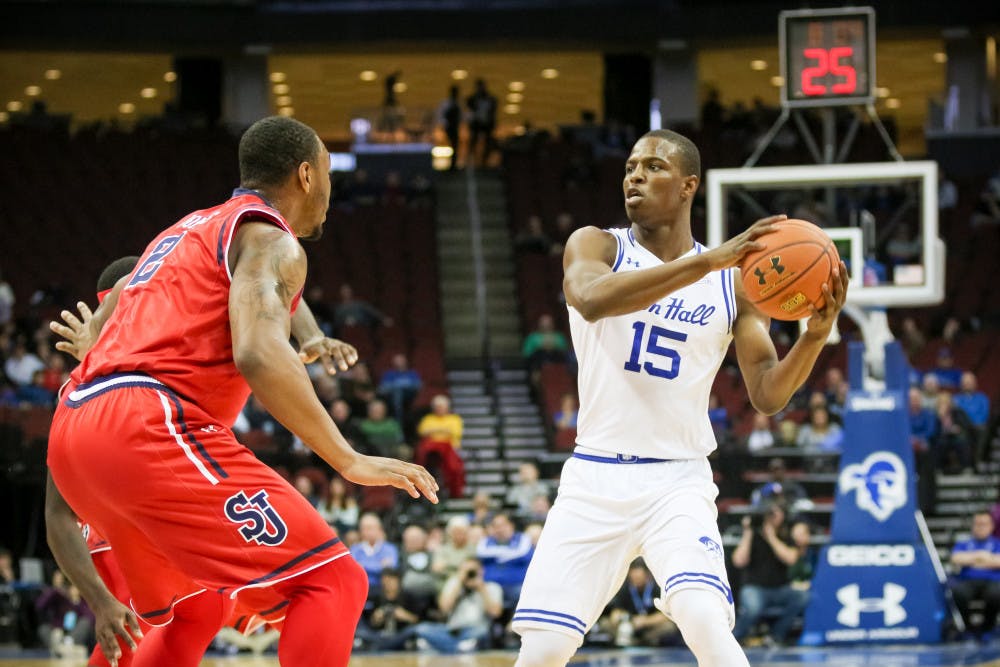[gallery columns="2" ids="13559,13560"]
The face of the men’s basketball program - the guy who was supposed to be the homegrown leader - left.
When Sterling Gibbs decided to transfer from Seton Hall, he fled for a typical contender in the University of Connecticut, leaving a team in South Orange on a nine-year NCAA Tournament drought in the dust.
Now, roles have changed: Seton Hall is the contender, while UConn is the one on the bubble looking from the outside in with Selection Sunday approaching.
Gibbs’ exit last season forced SHU to look away from older talent in favor of cultivating its young recruiting class, specifically point guard Isaiah Whitehead.
Whitehead was new to the point guard role this season. But in Gibbs’ stead, not only has the sophomore matched the transfer’s numbers, he has outdone him. Looking at Gibbs’ 2014-15 season with Seton Hall and Whitehead’s 2015-16 campaign, the numbers are similar. But comparing their conference play from those seasons provides uncanny resemblance.
If there is any facet between each player’s game that would be the most competitive and established, it is the three-point shot. Gibbs made a name for himself at Seton Hall as the clutch shooter, epitomized by his three-pointer to beat top-seeded Villanova in the Big East Tournament in 2014. As for Whitehead, he has proven this season that his three-point game is no joke, hitting shots with consistency and even from Steph Curry territory.
Comparing their clips from distance in conference play, the similarity comes as no surprise. Gibbs held a three-point mark of 42 percent against Big East opponents, while Whitehead put up a 42.6 spot. Both of them averaged 2.9 makes from three per game.
Gibbs and Whitehead also showed similarity from the field and in steals per game, but that is where the similarities fade between the guards.
There are facets to Whitehead’s game that Gibbs just could not - and did not - offer.
It starts at the line. Not only was Whitehead more accurate with a 70.6 percent clip over Gibbs’s 66.2, but his aggressiveness is exemplified by 1.2 more attempts per game.
Then come the blocks. Known to chase a player or two from behind to swat away the easy layup attempt, Whitehead averaged 1.7 blocks in conference play, while Gibbs offered up zero. Whitehead also snatched more off the glass, as he averaged 3.5 rebounds over Gibbs’ 2.4 boards.
On the other side of the floor, Whitehead outplayed Gibbs, posting 20 points per game in conference play against Gibbs’s 17.5. Whitehead also posted 5.5 assists per game over Gibbs’ 4.1 assists, but additionally turned the ball over more often than Gibbs.
With his new home at UConn, Gibbs’ numbers have dropped. His play has not elevated in his new role, and now he is at risk of missing the NCAA Tournament in his last eligible year.
Without Gibbs, Whitehead has filled and exceeded the production the senior guard left behind. Now, Whitehead and the Pirates are poised to dance, while Gibbs and UConn are still waiting on the edge of their seats to see if they are even invited.
Gibbs left, but the Pirates did not panic. Instead, they trusted their young point guard in Whitehead.
For Seton Hall, youth has reigned supreme.
Elizabeth Swinton is a TV production major from Linden, N.J. She can be reached at elizabeth. swinton@student.shu.edu or in Twitter @eswint22.
Comments


![IMG_8445[11695].jpg](https://snworksceo.imgix.net/sen/77f3c4ef-e856-4044-9e70-0b2095985e50.sized-1000x1000.jpg?w=1500&ar=16%3A9&fit=crop&crop=faces&facepad=3&auto=format)


